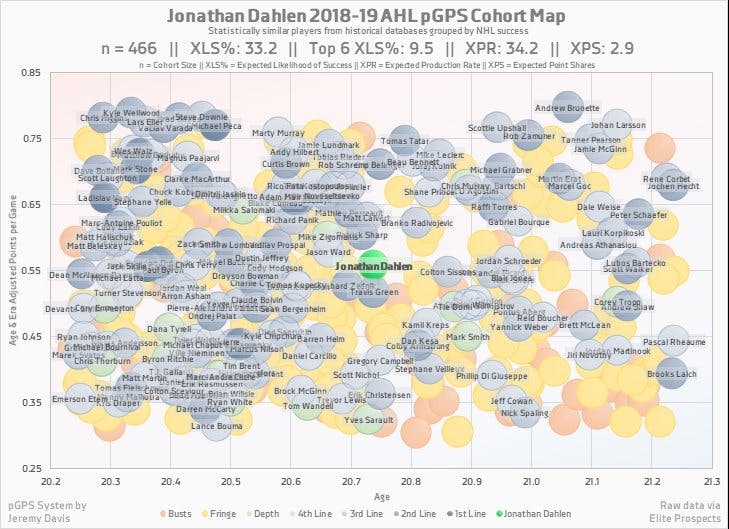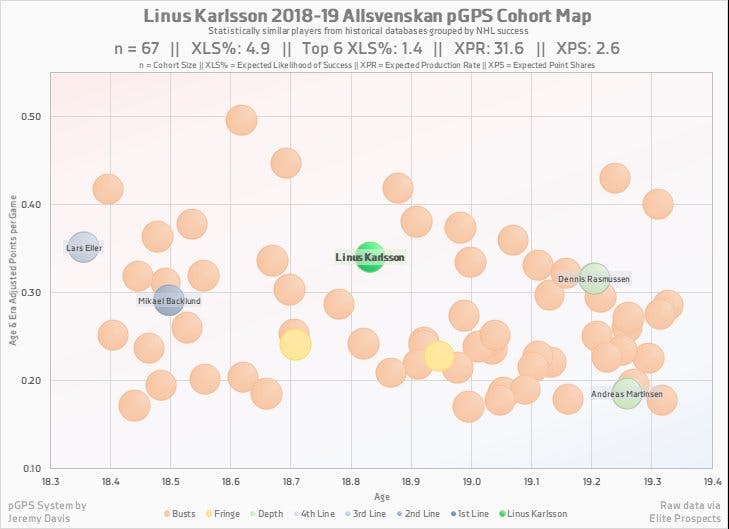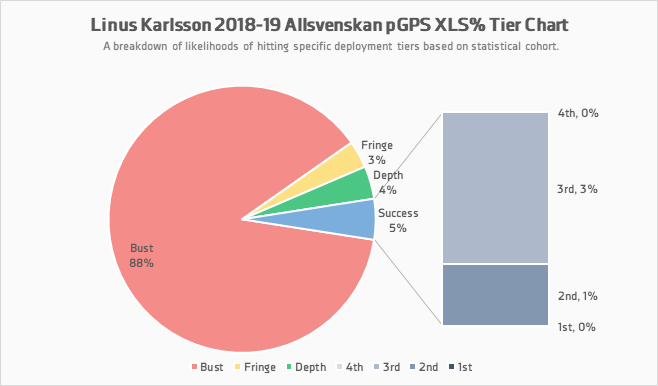First Look: Canucks Swap Prospects

5 years ago
In their second and less-publicized move on deadline day, the Canucks traded Jonathan Dahlen to the San Jose Shakrs in exchange for forward Linus Karlsson.
At first glance, the move looks like a bit of a head-scratcher, at least in terms of what the numbers say about the two players.




Viewed through the lens of the prospect Graduation Probabilties System (pGPS), players in Dahlen’s statistical cohort have a significantly better chance of graduating the NHL and making an impact than those in Karlsson’s.
Based on Dahlen’s first AHL season, his expected likelihood of success via pGPS is 33.2%, while Karlsson’s is just 4.9% based on his season with Karlskrona of the Allsvensken, Sweden’s tier-2 pro hockey league. When looking at the chance pGPS gives the respective players of filling top-six roles, the percentages are much lower; but Dahlen still ekes out the advantage with 9.5% to Karlsson’s 1.4%.
While I still believe pGPS is arguably the best publicly available tool for evaluating prospects from an analytical perspective, it has obvious limitations. Frankly, I’m getting tired of rehashing what those limitations are, but I’m going to anyway, because for some reason the accusation that the site “only looks at the numbers” have only increased since the site has taken more of a “big tent” approach after losing many of its brightest analytical minds to NHL teams or other hockey media outlets.
Because pGPS is focused on assembling a cohort of similar players to a given prospect, it can’t account for things like work ethic, context, usage, or any other number of factors. That’s why the system, and it’s predecessor, pGPS, are intended to be used in cooperation with traditional scouting rather than in opposition to it. The goal of pGPS is essentially to identify which players are the best bets, which players you should be looking at, and then hopefully utilize traditional scouting methods to identify which players belong to the percentage that makes the NHL, and which belong to the percentage that don’t. It’s very good for identifying which highly-touted prospects are perhaps overvalued, and which guys ranked in the lower rounds or languishing at the bottom of a team’s prospect depth chart are good bets to take a flyer on. As we get closer to the middle of that spectrum, the differences get less pronounced. Relying too much on just one element is how you end up signing MacKenze Stewart to an ELC or making a the declaration that Jake Wise was/is a superior prospect to Tyler Madden that will follow me to the ends of the Earth until the day I die.
All this is just a long-winded way of saying that the analytical perspective matters, but so does more traditional methods of analysis. I wasn’t very familiar with Karlsson as a prospect, so I reached out to Dobber Prospects’ Cam Robinson for his take on what the Canucks gave up, what they got in return, and his overall thoughts on how the Canucks fared in this trade:
“I always liked [Dahlen’s] play from the hashmarks down. Good nose for the net, strong edges, played strong. Wasn’t overly quick or boasting impressive top speed. He wasn’t big or fast which is a difficult combo to overcome. I felt he has/had some top six upside but likely a 3rd line guy.It’s disappointing [Pettersson and Dahlen] never got a chance in the NHL together. That said, if he asked to leave because he hadn’t been recalled, that’s on him. I’ve watched him a good amount in Utica this year. He’s been okay but not really pushing for an NHL job. I expect him to be a near-point-per-game guy in the AHL next year, but he’ll be in tough to crack that SJ roster too. Hopefully he has a bit more patience in him.”
“[Karlsson is] a mature, two-way pivot who turned down multiple SHL opportunities to stick with Karlskrona and play 14 minutes a night in the Allsvenskan this season. Needs to works on his acceleration – both with the puck and without. Not an overly creative player, he likes to get the puck and fire it when the opportunity arises. He’s a project pivot with some NHL upside.”“They won’t need to worry about expansion protection for Karlsson. I think Dahlen has top six upside. Not sure Karlsson has the same. Dahlen wanted a shot and apparently didn’t earn it so he wanted out. Can’t blame [Benning] for that. Like he said, somewhat lateral move.”
At this stage, it seems unlikely to me that this move has a very large effect on either of the teams involved. While I don’t know much about Linus Karlsson, I had plenty of opportunities to watch Jonathan Dahlen since he was acquired and I can’t say anything I saw ever quite lined up with the level of hype he generated during his time in Sweden. He has some upside, but also has a lot of work to do, and with reports indicating he asked the Canucks for a trade, you could do worse than swapping him for a project centre who’s two years younger and has a bit more room to grow. Based solely on the knowledge I bring to the table, it looks like a minor loss for the Canucks, but it’s unlikely this type of transaction would have occurred without the input of Thomas Gradin and/or Judd Brackett, who I generally trust when it comes to prospect evaluation.
In a vacuum, this deal really looks like it could go either way. It reminds me a bit of the Markus Granlund for Hunter Shinkaruk trade: the Canucks gave up on upside for a lower-ceiling player who they think can be a fit in their organization. That move ended up working out, though to what exact end is certainly up for debate.
What’s more important about this move is the discussions it ought to generate about the overall organizational philosophy when it comes to prospects and young players. The Utica Comets have been at the centre of a lot of controversy this year regarding their handling of young forwards, and while I’m skeptical about Jonathan Dahlen’s future, it’s undeniable that the one rookie on the team who’s season could be painted as a minor success story asking for a trade because of how he’s been handled is bad optics. Based on what I’ve seen from Dahlen, I’d say that he’s overestimated where he’s at as a pro hockey player, but with all the negative energy surrounding the Comets right now, I’d say the issue merits further organization if nothing else.
As far as the guy coming in is concerned, there doesn’t appear to be a hole lot there right now, but the Canucks have found diamonds in the rough in places others have looked before and it’s certainly possible they’ll do it again. Karlsson is buried a little bit on a middling Karlskrona team and it’s possible we could see an Adam Gaudette or Tyler Madden-like jump in production next season.





